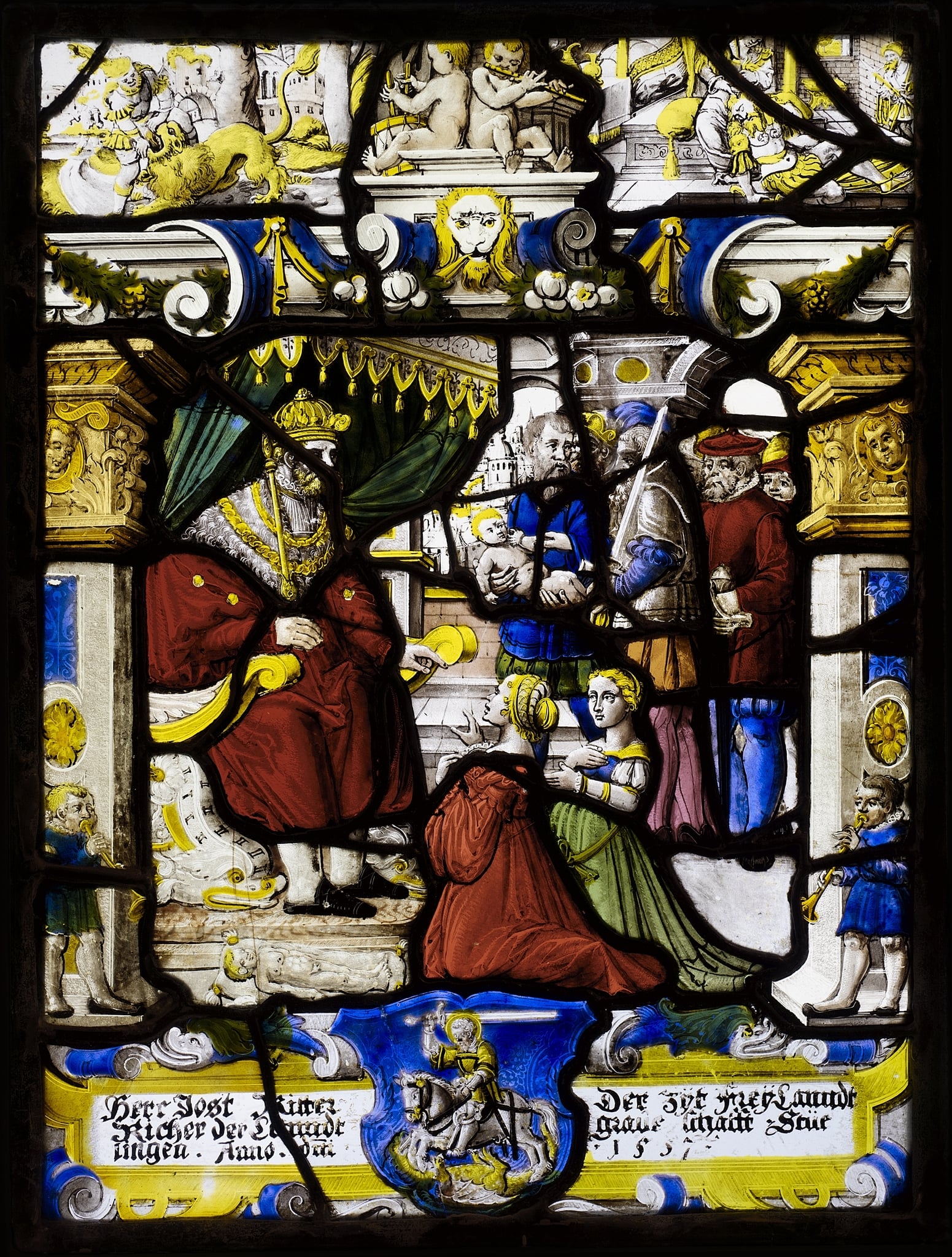The story of the Judgment of Solomon (I Kings 3: 16-28) takes place in an elaborate palace. Solomon is depicted in regal splendor, wearing a red, fur-trimmed robe with gold ornaments and chains. He is seated on a Baroque throne and holds a scepter in his right hand. He clearly dominates the composition, looking down at two women and the dead child lying before them. The story is clear by the actions. The two mothers argue; they both have given birth but one had rolled over during her sleep, suffocating her child. She took the child of her companion, substituting the dead child in its stead. Upon awakening, the second woman found the dead child but recognize that it was not hers. The dispute was brought to King Solomon. He asked that a sword be brought and proposed to cut the living child in half so that each of the mothers would be satisfied. The mother whose child had died agreed, but the mother of the living child pleaded that the child be kept alive and even if it were to be given to another. Solomon then proclaimed her to be the true mother. A man holds the living child. Next to him stands the executioner, who holds a sword, prepared to cut the live baby in half, if Solomon so decreed. The two sanguine-colored putti who sit above the lintel almost seem to be reminders of the dispute over the child.
In the Middle Ages Stühlingen in the Canton of Schaffhausen obtained a market charter and was a seat of justice. The donor, Jost Ritter, a judge of Stühlingen, clearly selected the story to reflect his profession. The emblem in his coat of arms, as well, appears to be a play on the donor’s name, Ritter (knight). The theme of Solomon appeared often in art from the Middle Ages through the Renaissance as an emblem of wise rulership and inspired legal judgments. Certainly, this was a time when an oath was of extraordinary importance in weighing testimony. How does one judge when an oath is false? The theme’s centrality for legal values can be seen some seventy years later in a German medal of Justice showing an equally elaborate Judgment of Solomon (Daniel Sailer, ca. 1625, Washington DC, National Gallery of Art, 1997.114.34.a; Pollard, 2007, vol. 2, no. 913). Solomon’s elaborate throne, and the throng of diverse individuals all engaged in dramatic action are similar, although the central position of the throne seems inspired by the Solomonic Judgment scene in Johann Fischart and Tobias Stimmer, Neue künstliche Figuren biblischer Historien of 1579 (Fischart, & Stimmer, 1880, p. 85). The Judgment of Solomon panel now in the historic Town Hall of Bremgarten, about twenty kilometers west of Zurich, attests to its broad and long-standing employment (Hasler, 2002, pp. 137–38, no. 20). The scene is surrounded by shields of ten individuals and the inscription reads: A wise judge and ruler makes decisions based on true principles, as did the wise Solomon. As his judgments were made then, so may they be made in this world, 1660.
Continuing the Old Testament focus, scenes from the story of Samson flank the central architectural motif above. To the left, Samson slays the lion, and to the right is the story of Delilah’s betrayal of Samson (Judges 16: 4-21). Samson had explained his superhuman strength: “I am a Nazarite, that is to say, consecrated to God from my mother's womb: if my head be shaven, my strength shall depart from me (Judges 16: 17). Delilah cuts off Samson's hair as he sleeps. A Philistine waits in the background, carrying the cords with which he will bind the weakened Samson.
The panel has been associated with the workshop of Hieronymus Lang, an artist discussed as the author of the Heraldic Panel with Double Arms of the Abbey of St. Blasien, Schwartzwald, and Abbot Caspar I Müller (US_21; JPGM 45.21.21). A panel with the Arms of Landenberg, von Reinach, Muntprat and Minstral (present location unknown; Hasler, 2010, 101, fig. 73) is dated and signed 1553. The sculpted pilasters at the sides, scene of the Samaritan Woman at the Well at the top and the putti on either side of the date are similar to depictions in the LACMA panel. Lang’s style shows a solid understanding of Renaissance perspective and modeling creating a believable architectural presence. In the canopy, the contrast of the deep blue-green drapery and the gold trim at the top establishes a powerful spatial recession. We also find an engaging dialogue. The woman closest to Solomon gestures with her hand while her animated profile evokes the earnestness of her conversation. Her adversary, in back of her, gives the impression that she is listening intensely. The viewer perceives a tense argument about possession of the child. Similarly, the men behind them interact. The man in blue who holds the child turns to speak to the man with the sword to the right. His face appears pensive and questioning, possibly to indicate his concern about Solomon’s suggestion that the child should be divided in half. The two scenes of Samson at the top are executed as drawings. They follow the tradition of the illustrated Bibles of the time, such as Hans Holbein's profoundly influential Icones veteris testamenti (Images of the Old Testament, printed in Lyons, 1547) focusing on linear simplicity.
Cited in:
Loewenthal sale, 1931, p. 37, no. 172, pl. 37.
LACMA Quarterly, 1945, pp. 5–10.
Normile, 1946, pp. 43–44.
Hayward, 1989, p.70.
Raguin, 2024, vol. 1, pp. 149–51.
